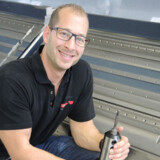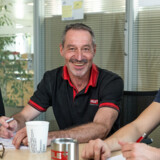

Spotfacing the rear bore edge can often be challenging. Too often those points are poorly accessible or the available space for the machining is very limited. This is aggravated by the fact that big machine stands and highest precision requirements de facto exclude a reclamping of the component for economic reasons. The following customer story shows how Starrag AG solved this problem by using the HEULE BSF back spot facing tool. Simultaneously they reduced their production time significantly and increased the reliability of their process.

Starrag is known for its five-axis machining centres that are used for the production of turbine blades. For their group sister company Bumotec, which offers machining solutions for the watch and jewellery industry, Starrag manufactures important machinery components such as for example the machine base at their location in Rorschacherberg. In doing so they meet the highest requirements of precision (e.g. flatness of 5my to 400mm2) or also parallelism as well as position tolerances.
The Starrag engineers took adavantage of the opportunity to source a more efficient back spot facing solution when a newly developed machine tool was about to be realized. Until today they used a manually pluggable back spot facer where the operator had to go into the machine twice for each bore. The new machinery parts have between 6 to 20 drilling holes. The dimensions of the drilling diameter/counterbore diameter are Ø11/Ø16.5; Ø11/Ø18; Ø9/Ø15; Ø8.5/Ø13.5 and the sinking depth varies between 5 to 44 mm. The raw material that is being used is cast iron (GGG).

The company was looking for a solution that allows an automatic and unmanned production. Their group own intercompany technology task force “Structural components” pursued the development of HEULE for quite some time. The components of the new series finally gave the opportunity for a first trial. Right from the beginning, they had the BSF backspotfacing tool in their minds to do this job. BSF was specifically designed for the automated operation and is applicable immediately without any anti-rotation devices as well as any anti-crash devices. The tool range covers bore holes from 6.5 up to 21.0mm and for countersink ratios up to 2.3 x bore diameter.


Before the tests were done the Starrag technicians raised concerns over the BSF tool. They were concerned if the tool was able to cope with the challenging and undefined cast skin as well as the different cast dimensions. In return, they felt very confident about the simple functional principle. Stefan Meier was convinced: “A tool design as simple as this will function reliably.” The BSF tool works as follows: after starting the spindle rotation applying the recommended activation speed, the carbide blade swings out into working position. To fold the blade back in again, the internal coolant is activated.
Thomas Eisenbart, responsible Product Manager at HEULE, supported the launch of the testing tools and shortened the learning curve to the minimum. Starrag was forced to implement big safety distances due to the varying cast dimensions (up to 8mm). This had a negative effect on the machining time. The quality of the surface however convinced the customer from the very beginning.
During one year of live operation the production staff gained some very instructive experience. The reliability was very high – as expected from Starrag. The blade housing remained free from any chips even though the the machining was done dry up to counterbore depths of 5mm. Internal coolant was used for higher measures only. The folding out and the retraction worked perfectly. Also no problems occurred regarding possibly polluted coolant.
The consistent maintenance has also contributed to a smooth operation. Beat Wirz, production employee, explains: “Before each use, we have checked and cleaned the tools. If required, the blades could be replaced easily.”
To finish Stefan Meier summarizes as following:
